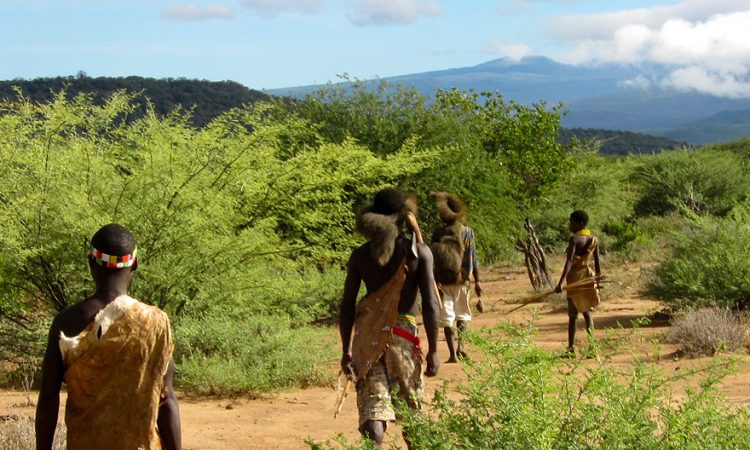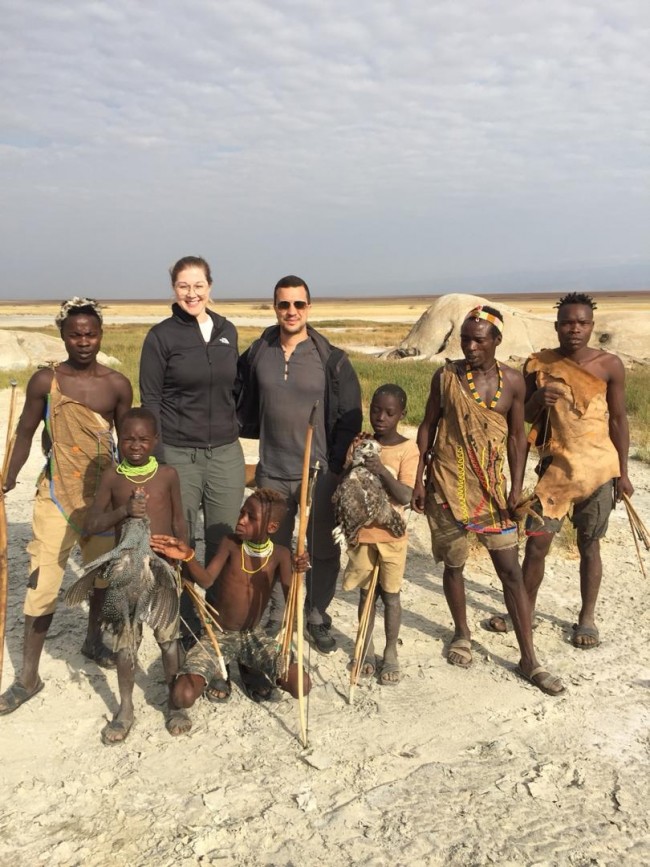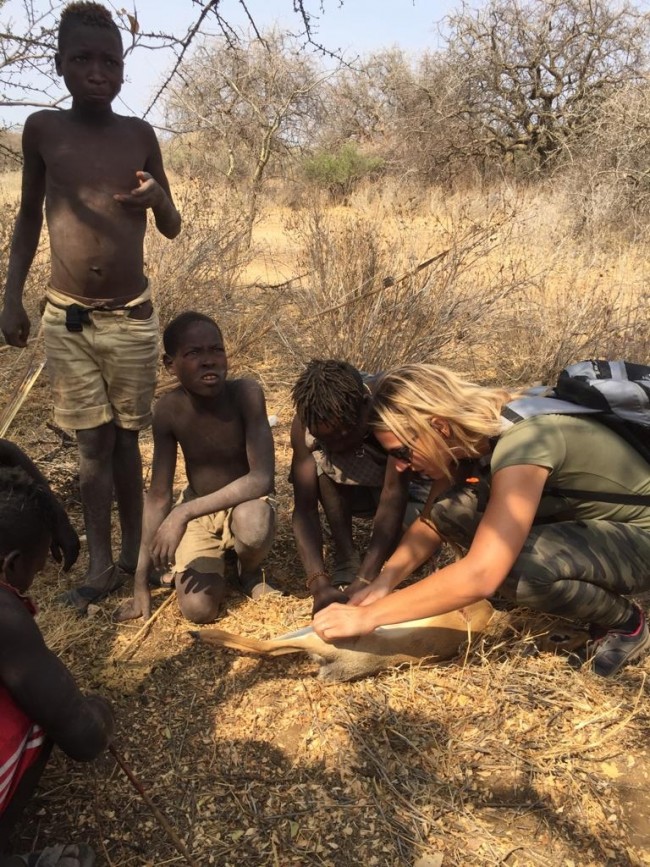Visiting the Hadzabe People at Lake Eyasi : The Masai are Tanzania’s most well-known ethnic group among visitors, especially those who are drawn to cultural tours. However, they only represent roughly 3% of this multiethnic country. The Hadzabe of Lake Eyasi are a smaller ethnic group. Their incredibly traditional way of life as hunters and gatherers is what makes them so fascinating.

Imagine being awakened in the early morning hours. Still exhausted, you rise from the antelope skin by the fire, rub your eyes for a moment, and perhaps sip some recently discovered water before gathering your bow and arrow and following the Hadzabe warriors into the savannah before dawn. Without having had breakfast, you follow the fresh footsteps of various wild species, including small rodent-like rodents, ostriches, ostrich-like birds, monkeys, impalas, and gnus. The prey is swiftly located. You take your first arrow, which has been dipped in desert rose poison, string it on the bow, aim it, and then gently let go of the string.

You return home with the recently slain meat. But a portion of the hunted animals is consumed first in order to quell the morning hunger. You walk over to a tree and use your machete to cut off a large branch where it joins the trunk while the baboon’s furred arm simmers over the fire that you yourself—at some time learnt via play—kindled after arduous study the night before. Wild honey is seen. The new defenders of the gastronomic haven that the honeybees have left rush to the front in excitement. However, the delicious temptation is too strong for you to resist, despite the ant-fighting unit’s best efforts. You insert your hand deep inside the hollow and take the delectable organic stuff. It is then time to prepare the shot animal, or at least its remains, for a feast at the camp so that everyone can enjoy it around the campfire in the evening. You laugh, sing, dance, and narrate tales about the hunt to one another. A strange day comes to an end, yet a memorable experience endures.
You need to leave your fantasy behind and look forward to your coffee and a satisfying breakfast. The majority of the large animals have long since left the hunting grounds, and the weight of civilization is becoming too much for the Hadzabe to bear. However, they are still around, giving you the chance to interact with them and spend at least a few hours walking beside them as they go about their daily lives.
Is it worth visiting the Hadzabe people at Lake Eyasi? Who are the Hadzabe?
There are about 1,000 Hadzabe people who still identify as such in Tanzania. They are situated south of Serengeti National Park, near the Lake Eyasi beach. There are thought to be 300 of them left who still live a fairly traditional life of hunting and gathering. They welcome visitors to join them in their regular activities. You have a fantastic opportunity to learn about a unique culture while sharing a period of ease and difficulty with one of the world’s remaining hunter-gatherer peoples. One of the few genuine living examples of how our ancestors lived before technological advancements like agriculture and modern weapons is the Hadzabe.
Contrary to many other traditional groups, the Hadzabe practice a very simple kind of religion. As a result, they follow few religious traditions and have less faith in the presence of strong supernatural powers that impart morality.
How do the Hadzabe live in Tanzania?
The Hadzabe reside in settlements known as “camps.” They fluctuate in size from 10 to 100 depending on whether it is the dry or rainy season. When there are fewer drinking holes during dry seasons and more animals are present at the remaining watering holes at the same time, the camps expand as well.
The groups will move sites as soon as the lair’s supplies run out. Every seven to eight weeks, this occurs. In a society where there is a division of labor, men consider themselves largely responsible for obtaining meat and honey, whereas women focus mostly on vegetarian diets. They gather wild fruits, including berries and figs, fruits, nuts, and tubers from trees and shrubs, gathering them from the environment or digging them out of the ground. The men don’t hesitate to engage in this behavior, especially if they are unable to obtain meat or honey.
Anthropologists like Frank Marlowe and James Woodburn affirm the Hadzabe’s high level of egalitarianism in various spheres of life. However, they do not downplay the fact that men do rule over women. But not significantly in comparison to other population groups. Therefore, it is clear that there are no leaders, and the group as a whole makes decisions. And, while being older earns you more respect, it does not make you more powerful than less experienced group members.
It’s interesting to see how they view possessions. They only have a few personal items, and material possessions are hardly ever used. Therefore, it makes sense that the Hadzabe historically were unaware of land ownership and the rights attached to it. Because of this, they were susceptible to abuse in the “modern” environment. They were given boundaries, which got smaller and smaller. In the meantime, increasing numbers of other populations encroached on their ancestral grounds and degraded them via practices like cultivation and livestock raising. Contrary to their cultural expectations, they were able to safeguard their already precarious existence by securing land rights thanks to their determination to survive. Difficult negotiations with the Tanzanian government came before this.
Is it worth visiting the Hadzabe people at Lake Eyasi? What can you expect?
Most importantly, you can interact with some of the last members of the indigenous population of East Africa. In a setting that seems “archaic,” you will find very modest living circumstances. Communication is initially only possible through your guide. Due to the click sounds used in their language, “Hadzane,” even repeating words is challenging. You might only be able to communicate with the Hadzabe later, if you are a little more accustomed to them. However, it feels like going back in time. It will seem as though you are in a totally different environment. It’s unlikely that they will be able to provide you with food or drink right away. They do not maintain stocks, Visiting the Hadzabe People at Lake Eyasi.

That fire might need to be lit first, depending on the time of day. You have a great chance to learn this skill out in the wilderness. Do not even request an internet connection so you can watch a YouTube fire-making tutorial. There can’t possibly be one here. You are fully dependent on the Hadza’s capacity to instruct. The dry season is when everything takes place outside. They construct upside-down bird nests during the rainy season out of long twigs and grass. Naturally, in a size that allows they room to live and sleep underneath. But this place is devoid of furniture.
The males may already be out hunting, and the ladies may be looking for fruits in the fields, bushes, or trees. Then you must first locate them. Despite the fact that the Hadzabe’s dwelling area has decreased by an estimated 90% in the past century, it is still possible to stroll around aimlessly for some time without running into anyone. Southwest of the Ngorongoro Crater, at the area’s center, is Lake Eyasi. The banks of the salty, drain less body of water are steeply cliffed. The northeast is decorated with acacia and palm trees. Sometimes more, sometimes less dense woodland may be seen in the surrounding area, with umbrella acacias and baobab bottle trees adding accents here and there.
You’ll start working together as soon as you’ve located the wandering Hadzabe women and men. However, don’t mistake stones for tubers. Additionally, avoid chasing the game away with rash actions. You might even give hunting a shot yourself. The bush craft professionals will instruct you on bow and arrow shooting during a rapid training session. It’s a delightful and educational experience in and of itself.
Please don’t anticipate a meeting without inconsistencies, despite the fact that the manner of life here may appear to be in a parallel universe to our own. For the Hadzabe to fully shield themselves from outside influences, modern society and the authority of the kings have gotten too close. For instance, wearing contemporary attire today is definitely more authentic than donning fur. The original’s core and closeness to nature may still be seen, though.
A trip to the Hadzabe is an excellent choice for people who want more from a Tanzania safari than just views of Mount Kilimanjaro, the Serengeti’s Great Wildebeest Migration, and Zanzibar’s beaches.
Tanzania has many notable attractions and tourist activities. If you’re interested in experiencing other cultures, the Hadzabe people provide a unique opportunity. Whether you’re going on a lodge safari or a camping safari, we are delighted to answer any questions you have and assist you in making and planning travel arrangements to Tanzania.


